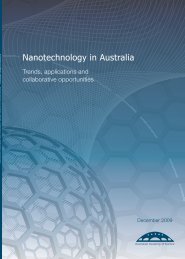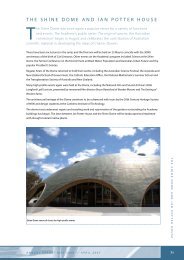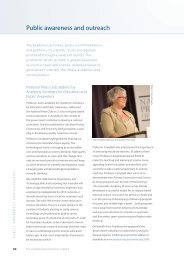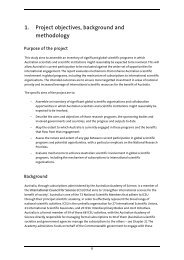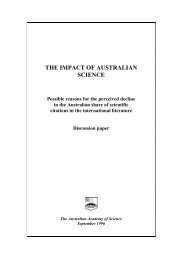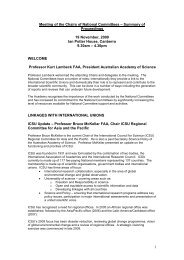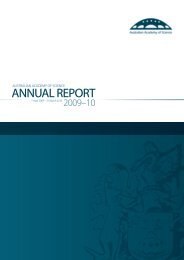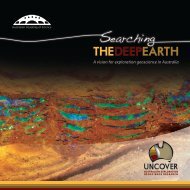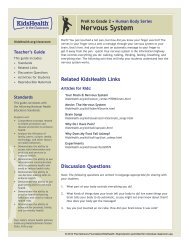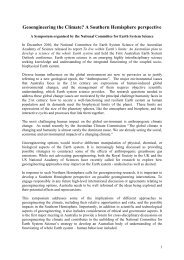Australia's Major National Research Facilities - Australian Academy ...
Australia's Major National Research Facilities - Australian Academy ...
Australia's Major National Research Facilities - Australian Academy ...
You also want an ePaper? Increase the reach of your titles
YUMPU automatically turns print PDFs into web optimized ePapers that Google loves.
How much of the strategic planning work can be done with existing resources, and what additional resources are required to complete<br />
the task?<br />
Astronomy<br />
Biomedical<br />
Sciences<br />
Chemistry<br />
The work cannot be done with existing resources. The current project plan for the Decadal planning process identifies an additional<br />
$100k in resources over and above the 5-10FTE ($1-2M) ‘in kind’ resources from the community to be devoted to the decadal planning<br />
process over the coming year.<br />
We have concluded that the NCBMS would not make significant progress with existing resources. This conclusion is based on recent<br />
experiences of at least one member of the NCBMS, specifically in the field of cancer in NSW; this is only one (small in many respects,<br />
but large in the public mind) field of research in one State and a huge amount of work was done by the committee commissioned to do<br />
the planning.<br />
In 1991 the RACI undertook a major Review, Strategic Review of Chemistry <strong>Research</strong> in Australia. The review was commissioned by<br />
the ARC, and conducted by comprising Professor Tom Spurling (now a current member of NCC), Professor Frank Larkins (recent<br />
former Chair of NCC), Mr Terry Robinson, Professor David Black (a former Chair of the NCC and now a current member of NCC), and<br />
Dr Paul Savage. The total cost was of the order of ~$350,000. The combined cost of the two planned reviews is estimated to be<br />
~$500,000 if conducted in 2004+. It is important to note that the current financial climate and business practise would mean that<br />
potential major contributors, e.g. CSIRO for the 2001 Review, would be reluctant to contribute “in-kind” support, so that ~$500,000 is<br />
“real money”.<br />
Other comments:<br />
• In 2004 the NCC will make a submission to EXCOM regarding the development of the synchrotron in Victoria.<br />
• NCC members attend the annual Professors and Heads of Chemistry Departments (PHODS) meeting at the end of January each<br />
year. The PHODS meeting is organised by the RACI, and the proposal for a Review (see question 3) was floated by the NCC<br />
Chair at the 2004 meeting.<br />
• The PHODS meeting is always held in Canberra. In future, it is anticipated that the NCC will meet in Canberra on the day<br />
preceding the PHODS meeting. The RACI International Committee also meets on this day in Canberra. This arrangement<br />
enhances the effectiveness of all three meetings held over these 3-4 days.<br />
• There are synergies between national and international activities. The report on international activities indicates this, e.g. the<br />
proposed development of a website which will include both national and international aspects.<br />
Crystallography<br />
Earth Sciences<br />
An executive secretary to drive the planning process would ensure it be done professionally and on-time. Dependent on the responses to<br />
this scoping questionnaire from the Chemistry and B&MB national committees, it might be feasible to share one executive secretary for<br />
all three Strategic Plans. Some travel support to allow at least two face-to-face meetings of the NCCr over the planning period would<br />
also be required.<br />
It is unrealistic to think that we can develop quality strategy with existing resources. If we are to develop strategy then it must be done<br />
properly: it would be a bad mistake to develop strategy badly. We had a grant of $45,000 to assist. The <strong>Academy</strong> provided in-kind<br />
contribution. Geoscience Australia provided significant in-kind contribution and the members of the committee paid their own (quite<br />
significant) costs for all the meetings. They also gave their time for free. Consequently the real cost is quite significant. However, some<br />
38



